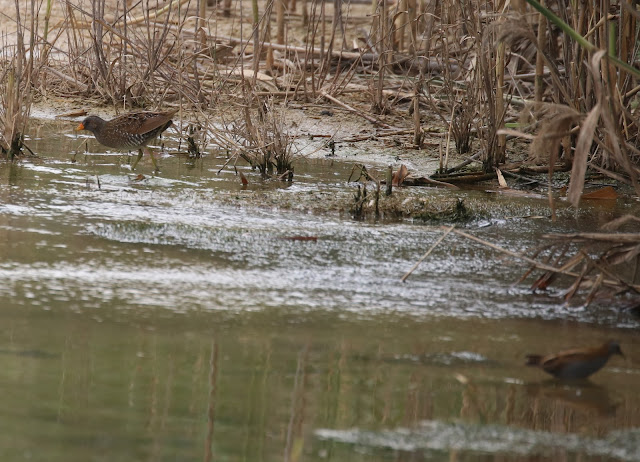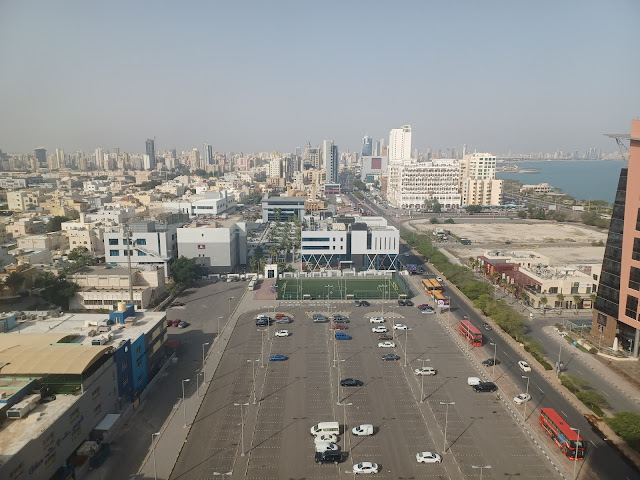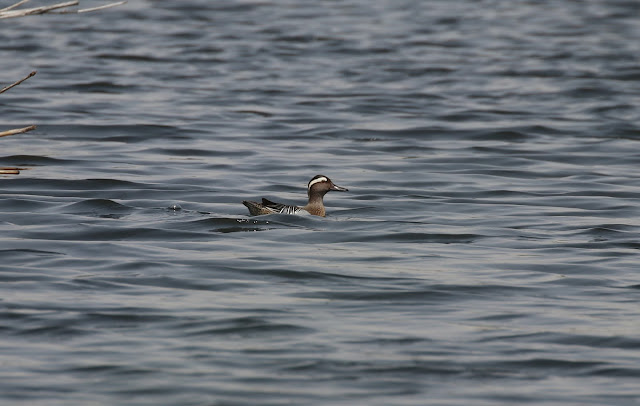27th March - 31st March 2024
Finally the warm Kuwaiti breeze was upon me as I left the airport after a really enjoyable flight from Heathrow on Qatar Airways connecting through Doha. A third attempt to get to the emirate, Kuwait was everything I had hoped for from the great birding to the in-country experience. It was a tough moment when the time had come to leave.
Having applied for my visa online, there was probably a bit of time-saving but it was still a bit of a faff getting my passport stamped. Similarly for the hire car, that requires payment of a local tax (£30) took another half hour or so but eventually I was on my way. The traffic was terrible and my first impressions of the city was of a typical oil rich state, large gas guzzling cars indicative of an oil-rich state driving chaotically along the wide highways. This wasn't for the faint-hearted.
Eventually making it to the hotel, it was nice to relax after a long day.
The king of the skies - Qatar Airways A380 preparing for the flight over to Doha.
It was Ramadan, A minor inconvenience that was totally overlooked when booking the trip. Breakfast was served to the room and thankfully there was plenty of it to last the day. The views from the hotel room overlooked the city, virtually desolate during much of the morning.
There are numerous birding sites within a relatively short distance from the hotel. No site was more than 45 minutes away which was probably the maximum amount of time I'd have wanted to be on the road. Prior to leaving the UK, Abdul Rahman the eminent birder in Kuwait sorted me out with a permit to Al Jahra Pools Reserve. Many of the sites are locked down, and without security clearance, it could be difficult to get through. Al Jahra Pools was by far the best reserve that I visited three times during this short trip.
So on my first full day in Kuwait, I headed over to the pools. Once through the security gate, there wasn't another soul around. The reserve was far larger than I'd anticipated. The tracks are easily drive-able with a number of hides located around the waterbodies.
The reserve wasn't teeming with birds but everything was a joy, like this ferruginous duck loafing on the pools viewed from the first hide I came to.
Plenty of garganey were also present with up to 25 birds loafing on this pool although they generally kept their distance from the viewing position.
When a heron suddenly explodes out of a reedbed, it definitely grabs your attention. This grey heron felt a little disappointing relative to the potential of something a little bit unusual. At least four squacco heron were present along the margins.
There were so many highlights here that included clamorous reed warbler, grey-headed swamphen, white-tailed lapwing, kentish plover, collared pratincole (below), slender-billed gull, gull-billed tern, greater spotted eagle, steppe eagle, delicate prinia, blue-cheeked bee-eater and European bee-eater.
A few Eastern imperial eagle were regularly seen soaring overhead
The graceful prinia with a little patience would often sit up nicely.
Returning back to Al Jahra Pools often provided views of species not seen on previous visits. Driving the tracks enabled the use of the car as a hide. It was just so thrilling to see blue-cheeked bee-eater and European bee-eater feeding together from roadside.
There were a few pools scattered around the reserve that could be viewed from the well maintained hides. One of these pools visited had a muddy margin that looked interesting so I waited for a short while to see if anything would appear. Not sure how often this happens in the region but having first seen a spotted crake pop out of the reeds, a baillon's crake and a little later, a little crake were simultaneously feeding along the margins. To top off the interest here, a bluethroat continued to dart in and out of the reeds at regular intervals.
On the same pool, a couple of white-tailed plover were warily wading through the shallow pools, a total of 11 were seen across the reserve.
The final visit to the pools under grey skies produced my first ever Isabelline shrike present within scrub on the seaward side of the reserve.
On the way back from the pools after the first visit there, I stopped off at the Kuwait Institute for Scientific Research (KISR). Unsurprisingly on arrival, the road leading into the site was gated and there was no way through, a feature of the country that excel in barriers and fences. Of course, it's a research institution and I shouldn't have expected anything else - however, I needed to somehow find a way in. In the end, it wasn't difficult a task, a 'chat' with one of the security guys (who didn't speak a word of English) seemed to understand that I wanted to boulder in to look at some birds.
It was evening and the area was very quiet, but there were a few interesting things here, including rose-ringed parakeet, white-eared bulbul, common myna, a hoopoe and this rather nice mosque.
The main reason for being here was to hopefully see grey hypocolious. This apparently is a reliable site for them but I had no idea where they might be. After wandering around the deserted streets of the institute, a small group of birds flew past me and headed to a plantation within a walled garden, it eas a relief to identify these as hypocolious. More small groups passed through, a total of 28 birds heading into the garden. I needed the scope to get a good look at them as they were frustratingly distant (see below), but was mighty relieved that the plan to drop in had paid off.
A small group of indian silverbill were also present here.
White-eared bulbul were relatively common but always enjoyed seeing them.
The Sulaibikhat Marine Reserve was another recommended site. Again, wasn't really sure what to expect, but having found a convenient parking spot by a mosque, a dirt track led to the vast expanse of intertidal sand. The weather was warm but thankfully a little overcast that made birding really pleasant.
The track ran along a tall fenceline which within it looked like a really promising area for something interesting. Noticing a gap in the fence, I decided to walk in, there was no one around so I thought I'd take my chances.
It got off to a fine start. A cinereous bunting flew past me and alighted at the top of one of the small shrubs that was a feature of the area.
A namaqua dove which I'd had fleeting glimpses of on the way down similarly stopped off allowing a closer look.
Elsewhere, an Eastern orphean warbler, four blue-cheeked bee-eater and a woodchat shrike was the best of the rest before making my way back out of what I'm sure was a prohibited area to the public.
The shoreline served up a lot of interest. Unfortunately it appeared that the crab plover that I was hoping for had left the area but there was plenty to see here including 77 greater flamingo, a Tibetan sand plover, terek sandpiper, marsh sandpiper, ten curlew sandpiper, a single Caspian tern, a Western reef heron, single glossy ibis, great (southern) grey shrike, and 24 black kite passing northward through the bay.
Another popular birding location for visitors to Kuwait are the Jahra Farms not too far from the Pools. These are working farms, so it does feel a bit strange wandering through while watching the locals go about their daily chores but people were friendly and there were no issues in spending a bit of time at this site.
There were a few interesting species present here, at least three bank myna were associating with their more common cousins. A couple of white-throated kingfisher looked spectacular as they shot through over the rice paddies resting in trees along the periphery of the site.
A real surprise was a female/1st year type semi-collared flycatcher that caught my attention just as I was leaving.
Al Shaheed Park is another popular site for visiting birders. Set within the bustle of the city, the park provides solitude in abundance from the mayhem of the city. Local workers invest a lot of time in making the park look pristine while being overlooked by the city skyline.
Despite the heavily manicured setting, the park does attract a lot of interesting stuff. A bit too early for the Basra reed warbler, it wasn't dripping with birds but the interest there included an Eastern orphean warbler, great reed warbler, masked shrike, red-backed shrike, tree pipit, white-throated kingfisher and hoopoe.
At the northern point of the financial district, Souk Sharq offers a rather nice walkway that passes by the bay with this boardwalk that provides a great vantage point across the water. Essentially an area for locals stepping out of the local mall, viewing from the end of the wooden walkway, a Socotra cormorant was feeding offshore with plenty of great cormorant and greater crested tern passing by on a lovely warm evening.
And that was pretty much it, a really enjoyable trip demonstrated by the sadness that I felt leaving. Travelling around was relatively straightforward, and while not a cheap country to visit (apart from the fuel prices), I promised myself that I would return. We'll see if that ever transpires but the birding is excellent despite restricted access to certain areas. It can be frustrating for that reason, but the quality of birdlife more than makes up for it.

















































Comments
Post a Comment